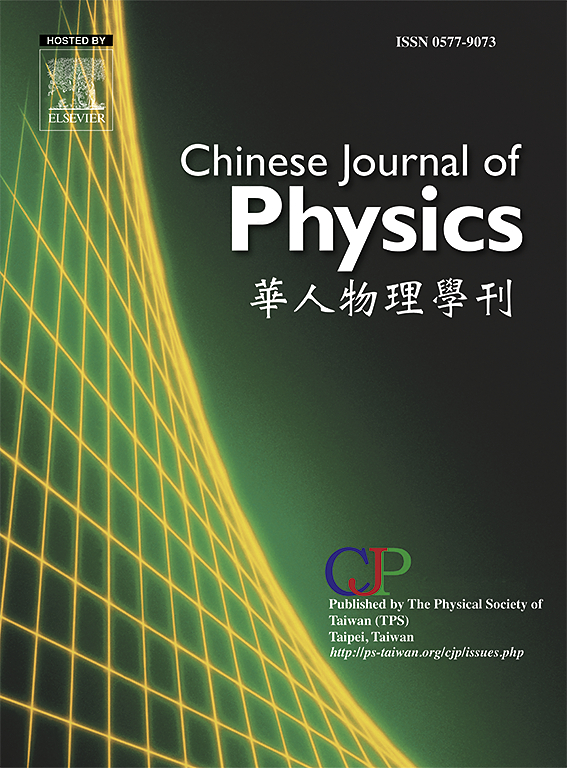Linear stability and parametric optimization of AA7075 nanofluid flow over an exponentially shrinking sheet under inclined magnetic field and thermal effects
IF 4.6
2区 物理与天体物理
Q1 PHYSICS, MULTIDISCIPLINARY
引用次数: 0
Abstract
This study investigates the linear temporal stability analysis of forced convection in water-based AA7075 nanofluid over an exponentially shrinking sheet, incorporating the effects of inclined magnetic field, Joule heating, and thermal radiation. Unlike previous studies that primarily focus on stability analysis, this research also explores the sensitivity of response functions. The governing ordinary differential equations, obtained via similarity transformations, are solved using MATLAB’s bvp4c solver. A parametric study is conducted over a range of physical parameters including magnetic parameter , inclination angle , suction parameter , shrinking parameter , AA7075 nanoparticle volume fraction , radiation parameter , and Joule heating parameter . The analysis reveals multiple solutions for certain parameter ranges and a saddle–node bifurcation is observed. Further, stability analysis confirms that only the first solution branch is stable and physically reliable. Increasing , and delays boundary layer separation. In the first solution, the gradient of velocity at the wall, represented by the skin friction coefficient, increases by 10.76%, 8.19%, and 8.23% with increasing magnetic parameter , suction parameter , and inclination angle , respectively. The incorporation of AA7075 nanoparticles into the base fluid results in a 48.28% enhancement in the temperature gradient at the wall, reflected through the Nusselt number, in the first (stable) solution. Additionally, the Joule heating and thermal radiation parameters contribute to an increase in the wall temperature gradient by 13.7% and 11.9%, respectively, indicating improved thermal transport efficiency. Sensitivity analysis using Response Surface Methodology (RSM) identifies nanoparticle volume fraction as the most influential parameter, with a desirability index of 63.9% yielding optimal values of drag coefficient (2.20139) and Nusselt number (13.6657). The results are validated against limiting cases from the existing literature and show excellent agreement. These findings provide significant insights for enhancing heat transfer and flow control in practical applications such as automotive cooling systems, fabrication processes, and energy devices.

倾斜磁场和热效应下AA7075纳米流体在指数收缩薄片上流动的线性稳定性及参数优化
考虑倾斜磁场、焦耳加热和热辐射的影响,研究了水基AA7075纳米流体在指数收缩薄片上强迫对流的线性时间稳定性。与以往的研究主要集中在稳定性分析不同,本研究还探讨了响应函数的敏感性。通过相似变换得到的控制常微分方程,利用MATLAB的bvp4c求解器进行求解。对一系列物理参数进行了参数化研究,包括磁性参数(M)、倾角(γ)、吸力参数(S)、收缩参数(λ)、AA7075纳米颗粒体积分数(φ)、辐射参数(R)和焦耳加热参数(J)。分析结果表明,在一定参数范围内存在多个解,且存在鞍节点分岔。此外,稳定性分析证实,只有第一个解决方案分支是稳定且物理可靠的。增加M、S和γ延迟边界层分离。在第一种解中,壁面处的速度梯度(以表面摩擦系数表示)分别随着磁性参数(M)、吸力参数(S)和倾角(γ)的增大而增大10.76%、8.19%和8.23%。在第一种(稳定)溶液中,将AA7075纳米颗粒掺入基液中,壁面温度梯度提高了48.28%,这可以通过努塞尔数反映出来。焦耳加热(J)和热辐射(R)参数使壁面温度梯度分别提高了13.7%和11.9%,表明热传递效率得到了提高。利用响应面法(RSM)进行敏感性分析,纳米颗粒体积分数是影响最大的参数,可取指数为63.9%,得到阻力系数(2.20139)和努塞尔数(13.6657)的最优值。从现有文献的有限案例中验证了结果,并显示出极好的一致性。这些发现为在汽车冷却系统、制造工艺和能源设备等实际应用中加强传热和流动控制提供了重要的见解。
本文章由计算机程序翻译,如有差异,请以英文原文为准。
求助全文
约1分钟内获得全文
求助全文
来源期刊

Chinese Journal of Physics
物理-物理:综合
CiteScore
8.50
自引率
10.00%
发文量
361
审稿时长
44 days
期刊介绍:
The Chinese Journal of Physics publishes important advances in various branches in physics, including statistical and biophysical physics, condensed matter physics, atomic/molecular physics, optics, particle physics and nuclear physics.
The editors welcome manuscripts on:
-General Physics: Statistical and Quantum Mechanics, etc.-
Gravitation and Astrophysics-
Elementary Particles and Fields-
Nuclear Physics-
Atomic, Molecular, and Optical Physics-
Quantum Information and Quantum Computation-
Fluid Dynamics, Nonlinear Dynamics, Chaos, and Complex Networks-
Plasma and Beam Physics-
Condensed Matter: Structure, etc.-
Condensed Matter: Electronic Properties, etc.-
Polymer, Soft Matter, Biological, and Interdisciplinary Physics.
CJP publishes regular research papers, feature articles and review papers.
 求助内容:
求助内容: 应助结果提醒方式:
应助结果提醒方式:


